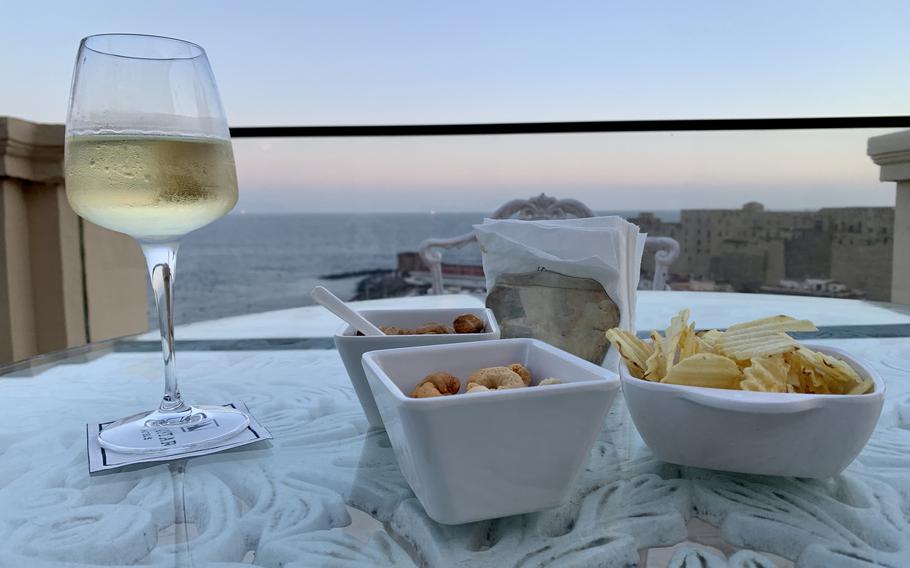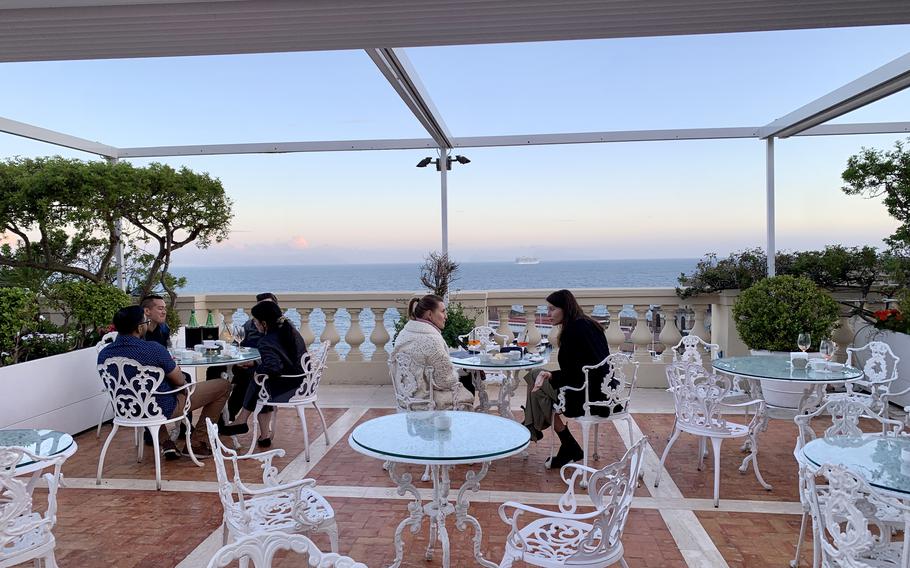
Cocktails at Terrazza La Dolce Vita at Naples' Hotel Excelsior come with complimentary snacks and panoramic views. (Alison Bath/Stars and Stripes)
For many, Naples is a pitstop on the way to an Amalfi Coast destination.
Visitors often don’t see much of the city beyond its pizza restaurants and Via Toledo crowded with chain stores, fast food eateries, bakeries and gelato shops.
But if you know where to look, you can see another side of Naples that pays homage to its history, art and culture.
Here are five lesser known ways to gain a deeper appreciation of the City of the Sun:
Devil of Mergellina
Busloads of tourists travel by the small Church of Santa Maria del Parto in Naples’ Mergellina neighborhood without realizing the modest building is home to a 16th century painting with an intriguing backstory of sorcery and seduction.
Painted in 1542 by Leonardo Grazia, the Devil of Mergellina depicts the vanquishing of a devil-woman by the Archangel Michael, according to visitnaples.eu.
It represents the triumph of Diomede Carafa, the Bishop of Ariano Irpino, over temptation that came in the form of a beautiful Neapolitan woman. Legend says the woman cast a love spell on Carafa that drove him mad with desire. To break the spell, the bishop was advised by an exorcist to commission the painting.
The small, Baroque-style church also is home to the tomb of the Italian poet Jacopo Sannazaro. Worth a visit nearby is the tomb of the ancient Roman poet Virgil at Parco Vergiliano de Piedigrotta.
Via de Mergellina. Open 7:30 a.m.-noon; 5 p.m.-7:30 p.m., Monday-Sunday. +39 081 664627; http://www.santamariadelparto.it/
Quartieri de Chiaia marketplace
Not far from the Church of Santa Maria del Parto is a piazza with a market selling flowers, fresh fish, vegetables, fruit, cheese, pasta and other foods.
There are a variety of stalls and shops on the piazza but a venture inside an adjacent covered walkway reveals a hidden bonus of other vendors selling toys, books and more.
Nestled in a back corner is the popular eatery Cibi Cotti “Nonna Anna,” where you can get inexpensive, cafeteria-style lunch and dinner specials from a changing daily menu of traditional Neapolitan fare. A recent menu included a rice salad with octopus, pasta with white beans and meatballs. For about 10 euros, you can get first and second courses, and a vegetable side. Eat your meal there or take it with you and find a place to sit along Naples’ Lungomare, which features views of the sea and Capri.
Riveria de Chiaia, 15, Naples; hours vary, open daily.
The elliptical staircase
One of Naples’ finest examples of Italian art nouveau, or Liberty Style, architecture is the Palazzo Mannajuolo in the city’s fashionable Chiaia neighborhood. Designed by the architect Giulio Arata and opened in 1911, the palazzo features a mesmerizing elliptical staircase that climbs several stories.
Visitors can view the staircase with its marble steps and wrought iron banister from the ground floor. But the rest of the building is closed to the public, so don’t attempt to go further or you’ll draw unwanted attention from building security.
A vestibule near the staircase includes information about the palazzo and its construction, although it does not have an English translation.
Once you’ve viewed the staircase, go right as you exit the building and walk up the street turning left to continue a half-block or so up Via dei Mille. Turn around and you’ll be treated to a view of the palazzo’s stunning façade, complete with a faux dome. It’s along this street and Via Gaetano Filangieri that you also can indulge in window shopping at stores such as Prada, Gucci and Hermes.
Via Gaetano Filangieri (there is a historical sign outside the palazzo); Open 8 a.m.-6 p.m., Monday-Saturday.
A Michelangelo angel, maybe
Complesso Monumentale Sant’Anna dei Lombardi, founded in 1411, features the work of several famed Renaissance sculptors, including Guido Mazzoni, Antonio Rossellino, Benedetto de Maiano and, perhaps, Michelangelo.
De Maiano, from Florence, created an altarpiece in the Chapel of Marino Correale, which was built in 1490 and is on the right as you step into the church.
Historians theorize that an angel at the top right of the altar was created by a teenage Michelangelo. The twisting of the angel’s torso and wry smile, among other features, are characteristic of the famed Italian sculptor, painter, architect and poet, who likely was a student of de Maiano, according to the church.
While you can see much of the complex for free, there’s a 6 euro charge to view the Correale chapel, Lamentation over the Dead Christ by Mazzoni, and stunning frescoes by Georgio Vasari, who was inspired by Michelangelo to create a small Sistine Chapel in Naples.
Piazza Monteoliveto, 4; Open 9:30 a.m.-6:30 p.m., Monday-Saturday; 12:30 p.m.-5 p.m. Sunday;
+39 391 794 4140, https://www.santannadeilombardi.com/it/

Terrazza La Dolce Vita at Naples' Hotel Excelsior, along the city's famed Lungomare, offers the ideal spot to have a cocktail and nosh while taking in panoramic views. (Alison Bath/Stars and Stripes)
Aperitivo with sunset and sea views
Few bars in Naples offer panoramic views and the chance to get away from the crowds like the Terraza La Dolce Vita at Hotel Excelsior.
The 7th floor terrace is decorated in quintessential style with white wrought-iron tables and chairs. White-jacketed waiters will bring your drink order and complimentary snacks of potato chips, crackers and mixed nuts. You can munch away while viewing Mount Vesuvius, the Gulf of Naples, Capri, Ischia and the sunset over Posillipo.
The best part is that the cost isn’t much more than you would pay at a noisy, crowded bar on the street. On a recent visit, I paid 8 euros for a glass of white wine, although most mixed cocktails range from about 10-12 euros.
Via Partenope, Via Francesco Caracciolo 48; Open daily, noon to midnight; +39 081 764 0111, https://www.eurostarshotels.it/